Jan Eric Löwenadler – Sweden's most prominent art dealer

Löwenadler Collection
Bukowskis is proud to present the Löwenadler Collection. The collection consists of fantastic art and decor from the home of one of Sweden's most prominent art dealers, Jan Eric Löwenadler. A collection that over the years followed its owner to his many homes in different countries. Homes that reflect Jan Eric Löwenadler's great passion for interior design. The collection in its fill can be seen as a historical document characterized by huge big names and a taste of the '80s.
The start of Jan Eric Löwenadler's life work became "Galerie Löwenadler" on Karlaplan 9A. At the gallery opening, 5,000 invitation cards were printed and on the white walls were hung oil paintings, tapestries, collage and graphics by the father of op art, Victor Vasarely. The choice of artist was well thought out as Jan Eric wanted to open with an artist who was world famous and yet relevant. The opening became the big event of the fall at Stockholm's art scene and the artist's most extensive exhibition in Stockholm.
With the opening, Stockholm got a new vibrant and lively gallery, which took off in the founder's own personality. The varnish saws turned into parties with princesses and the entire cultural elite, widely documented by mingling photographers. Jan Eric became known for his outstanding ability to mix guests for a dynamic event. He believed that galleries would be commercial places of life where people could meet and the then "youngest gallerist in Stockholm" started a new era in the gallery industry. The exhibition with Vasarely was followed by artists such as Louis Féraud, Andy Warhol, César, Valerio Adami, Howard Kanowitz, Yaacov Agam and Jesús Rafael Soto.
As an art dealer he was a commercial, privately he traded with his heart. By chance, Jan Eric discovered that he shared tailor with Pablo Picasso, which emerged when the artist signed drawings to pay the bills. The Swede bought the sketches and sold them to Galerie Bleue in Stockholm. Jan Eric believed that good art is about idea and ideology. The feeling is more important than the decorative. The art came to characterize Jan Eric's life. His home became a place for both his commercial art trade as well as his private collection.
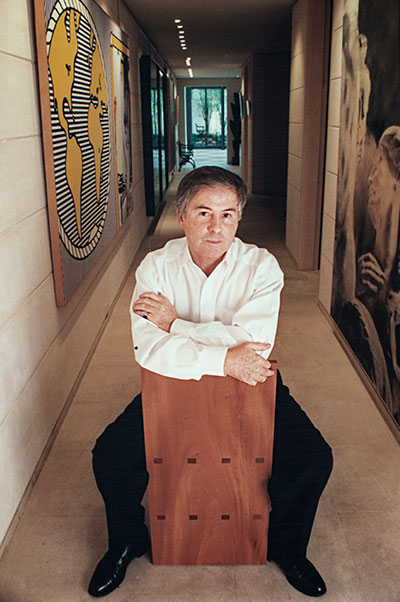
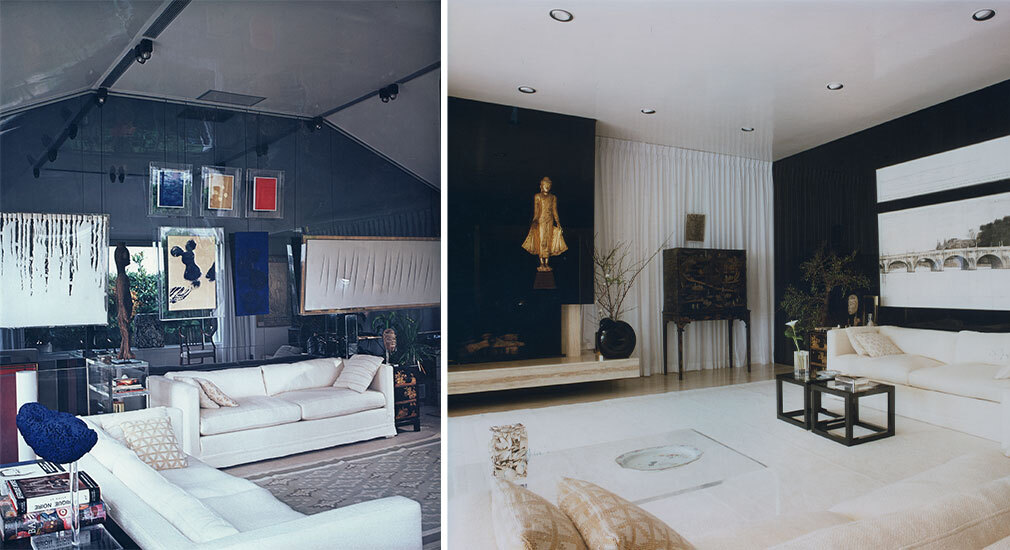
Jan Eric Löwenadler's home in Paris and in Los Angeles.
The French apartment was filled with significant works of art; Lucio Fontana, Auguste Rodin and Yves Klein. In Paris he also acquired works by Louis Morris, Kenneth Noland, Jim Dine and Robert Rauschenberg which he later had on his walls in his house in Los Angeles, where the next move would go. He was determined to create a perfect setting in the sun and therefore took most of his possessions with him. At the top of the smog on Doheny Drive in the Hollywood Hills, Jan Eric came to find a house with a dramatic view of the Pacific Ocean. The home came to be characterized by contrasting styles and an impeccable sense of detail. A white theme with elements of black lacquer met Japanese minimalism in the form of a pool and greenery.
The entrance was met by thick rugs by Fernand Léger and Pablo Picasso, which was combined with a monochrome cobalt blue work by Yves Klein and a Jean Dubuffet sculpture. Yves Klein was a favorite for Löwenadler who exhibited the artist's work at the Grand Palais in Paris. The French artist was challenging, expressive and ahead of his time – just like Jan Eric himself.
The dining room walls were clad with seven murals by Pablo Picasso that the artist had painted in Biarritz in 1917 to enhance his private bedroom which was previously cold and simply decorated. The paintings in blue on a terracotta toned base, were matched with Swedish Gustavian chairs. The chairs were a family legacy that came to follow Jan Eric throughout his life. Under the tasteful travertine table lay a Chinese rug, which brought up the colors of the murals on the walls.
After Los Angeles, Löwenadler moved to Manhattan where he started Bonlow Gallery with Jeanette Bonnier. Bonlow Gallery, (named after the first three letters of their respective names) opened the gates in 1982 on Greene Street in Soho next to the legendary Leo Castelli Gallery. The first exhibition was with the sculptor Owen Morrell, whose varnish was visited by, among others, the Swedish king and then the head of the Museum of Modern Art. During the relatively short period that the gallery was open, artists mainly exhibited in the postmodern art directions that blossomed on the art scene during the early 80's in New York.
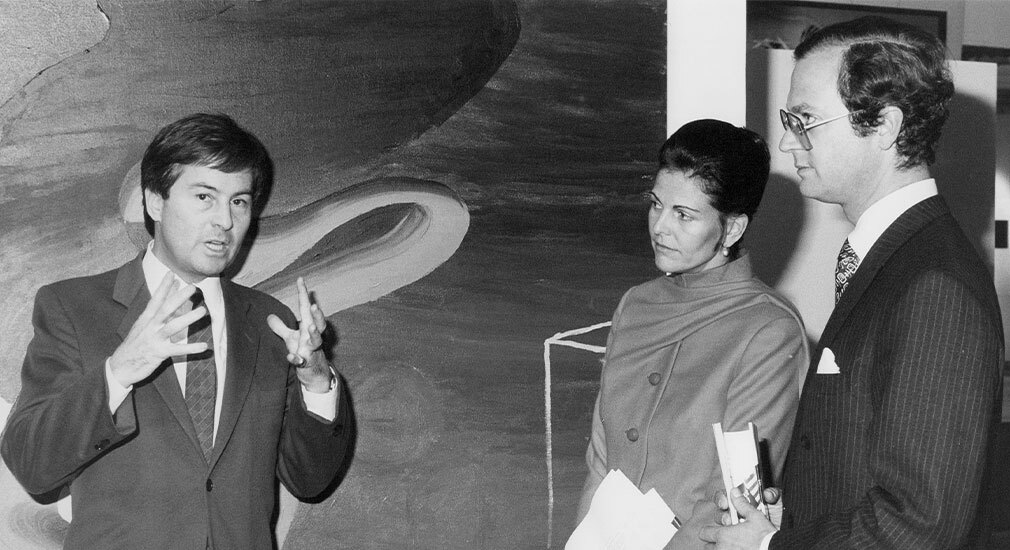
Jan Eric Löwenadler with the Royal Highness of Sweden Carl XVI Gustaf and Queen Silvia.
In New York, he settled on 64th Street in the upscale Upper East Side neighborhood, with both the Swedish Consulate and Guggenheim. Jan Eric got stuck for a five-storey townhouse and his own private courtyard. Together with architect Per Öberg, the house was tastefully renovated like an art hall, and it became more or less a private gallery where most of the art shops took place. The exclusive and tasteful home became a place for artists, investors and locals. During the 1980s boom of art and the yuppie era, prices in the art market reached staggering heights. The art industry was red-hot and the hub of world-wide commerce had been concentrated in the United States.
Jan Eric himself has said that he was fortunate to be in the right place at the right time - hence his great success as an art dealer. During the late 1980s, he had a turnover that was more than twice the size of all Swedish auction houses in total. The 650 square meter house was filled with bold architectural solutions and contrasts. The traditional facade in typical English townhouse style contrasted with the interior's modern interiors containing a lounge, library, music room, bedroom, kitchen, dining room and study room as well as a third floor, entirely intended for guests. On the entrance floor there was a reception with office and gallery.
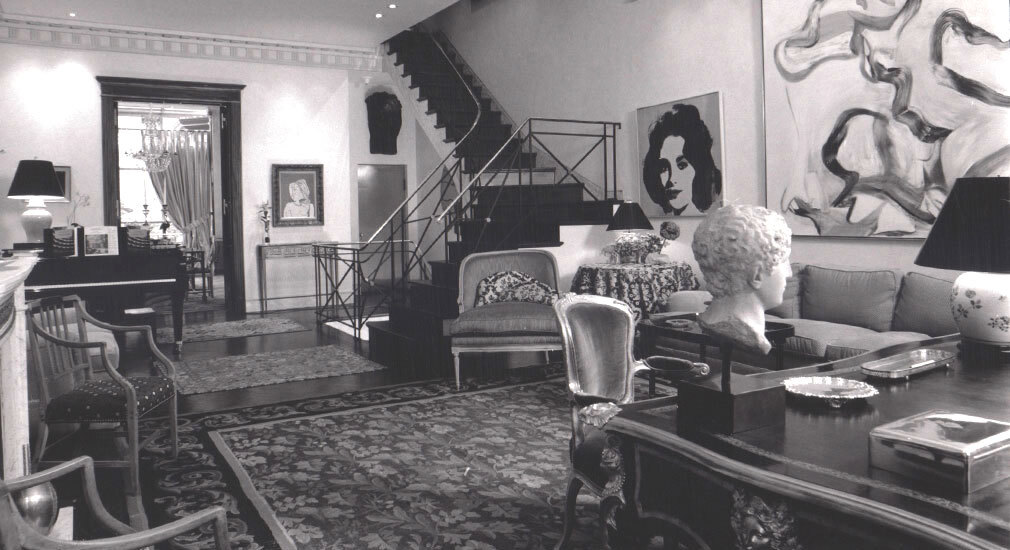
The living room in Jan Eric Löwenadler's magnificent house on 64th street in New York.
The house also had a magnificent atrium facing the courtyard. The atrium, which had a beautiful patterned brick and limestone floor, also had a sunken Roman bath. Next to it, a mural painting by the minimalist American artist Sol LeWitt - which he would later also perform in Stockholm. The sculpture garden had works by both Joel Shapiro and Alexander Calder. Roman marble heads were combined with works by Jean – Michel Basquiat, Roy Lichtenstein and Willem de Kooning. Nothing was left to chance, every detail thoughtfully thought out. The house had a number of dramatic and theatrical elements, and was therefore an excellent meeting place for business, events and parties.
Over time, however, a longing returned to Stockholm and in the late 80s he bought two floors in a turn of the century on Narvavägen, which he let architect Per Öberg redecorate into a one-story apartment totaling 437 square meters. Initially, the dwelling consisted of a king-room and a raw wind, which later became a residence in nine rooms that included a magnificent roof terrace, an orangery, two libraries, two kitchens and four bathrooms. The home, which was on the fifth floor of a terracotta tones property, was tastefully renovated with exclusive materials and wonderful views of Stockholm.
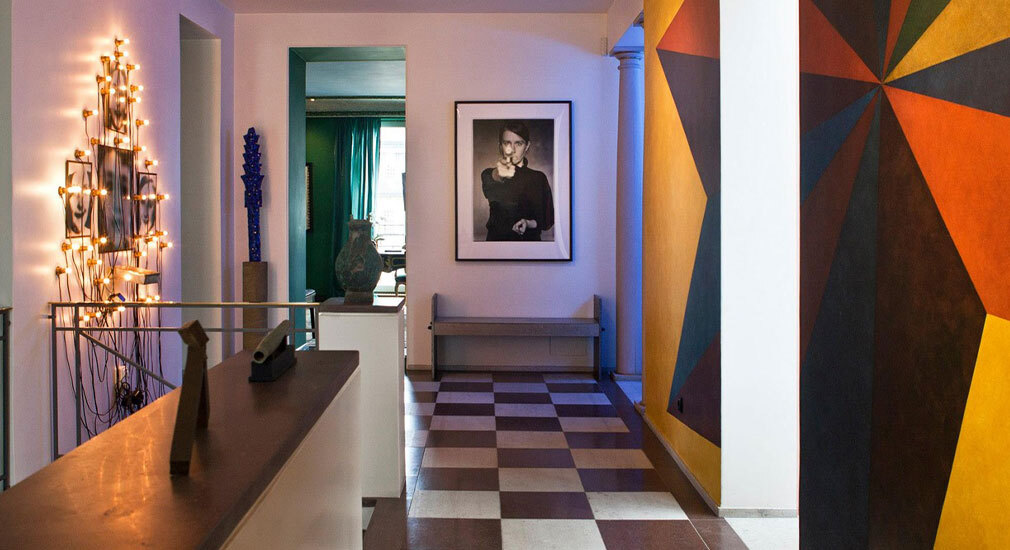
The entrance to Jan Eric Löwenadler's home at Narvavägen in Stockholm. Bid on Cecilia Edelfalk's self portrait here >
Jan Eric believed that high quality art and design could always be combined, regardless of the era. The floor in Stockholm was first class remodeled but differed in style from his previous home, with intense but harmoniously saturated colors. In the museum's minimalist hall they were met by a gun barrel in Cecilia Edelfalk's well-known self-portrait, one of the few Swedish works owned by Jan Eric. The mural painting by Sol LeWitt, which Jan Eric initially had in his home in New York, was repainted in Stockholm following the artist's instructions. A Chinese urn was placed next to a grain-blue sculpture by Ned Smythe and an installation with the Holocaust as the theme of Christian Boltanski could be seen in the hall.
Downstairs in the eclectic home, Jan Eric had the architect Per Öberg design a banquet hall with built-in orangery, "The Greenery", like a Roman villa. Here you could enjoy lush plants and live trees and shrubs. The walls went in emerald green and the hall was decorated with three glass tables by Grant Larkin Ltd, which were raised by figures á la Giacometti matched with sixteen Gustavian chairs from the 18th century, placed on an antique Aubusson rug that harmonized with the chairs. On the wall hung the work "Bad Mother" by Francesco Clemente, an altarpiece by Starn Twins, "Christ after Titian" and a Precht mirror. Opposite the illuminated greenery hung the dramatically illuminated "Petrified Forest" by Mimmo Paladino. The architect Per Öberg also let the English decoration painter Francis Gregory decorate both the wall and ceiling with stucco splashed in gold.
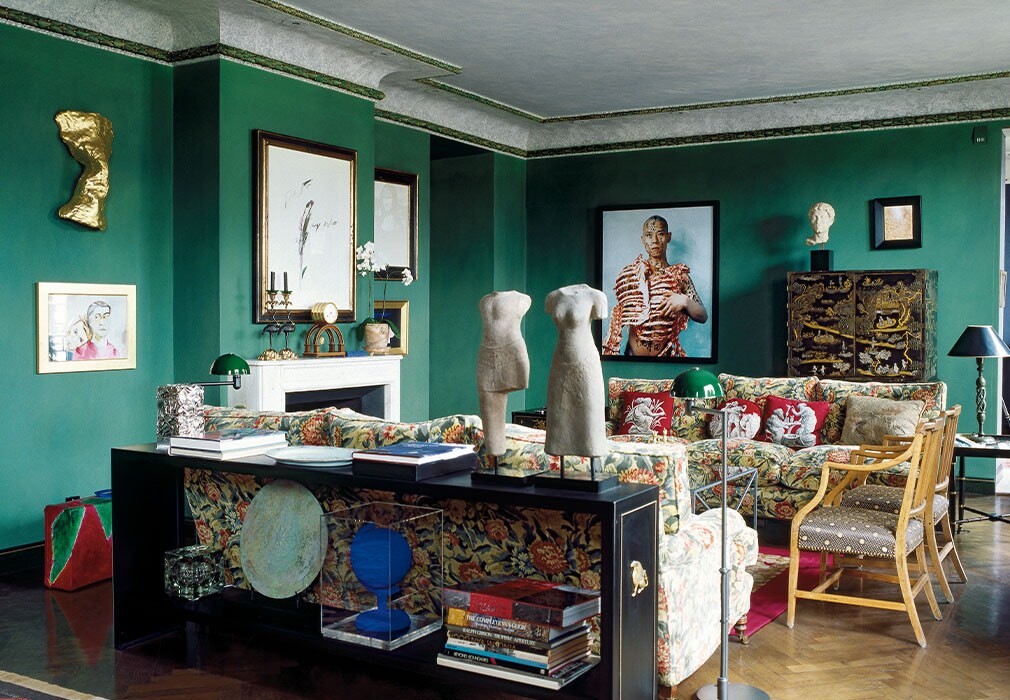
Jan Eric Löwenadler's living room at Narvavägen in Stockholm. Photo: Anne Nyblaeus
On the lower floor there was a very well-stocked library decorated with furniture from Svenskt Tenn. In the magnificent salon there was a self-playing grand piano, a Cy Twombly watercolor, "Key West", and an Asian 18th century cabinet with mother-of-pearl inlays, a work by provocative Chinese artist Zhang Huan, a globe by Yves Klein. Jan Eric also collected Etruscan urns and Roman figurines. The ceiling of the salon was decorated with stock leaves with gold-plated berries. The French 18th-century fireplace, which framed the room, was purchased in New York and transported to Narvavägen for installation.
The stairs upstairs were designed as a glass chapel where light hits the parquet floor in cascades. A wood mixing technique, "Tondo", by Mimmo Paladino framed the stairwell and was accompanied by Allan McCollum's "Perfect Vehicles" from 1986. A spectacular glass bridge led to the terrace which also had a breathtaking view of Stockholm. From his good friend Keith Haring, Jan Eric received a plaster painting cut from the artist's own wall, which he named himself Esprit d'escalier.
Image to the left: Jan Eric's beautiful desk, a Régence and style, Ormolu – Mounted Bureau Plat, 18th century and later. View the desk in the catalogue > and an armchair, Louis XV, France, 18th century and later. View the armchair in the catalogue >
Photo: Anne Nyblaeus
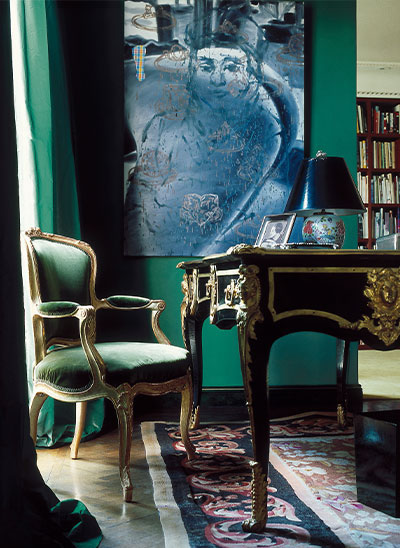
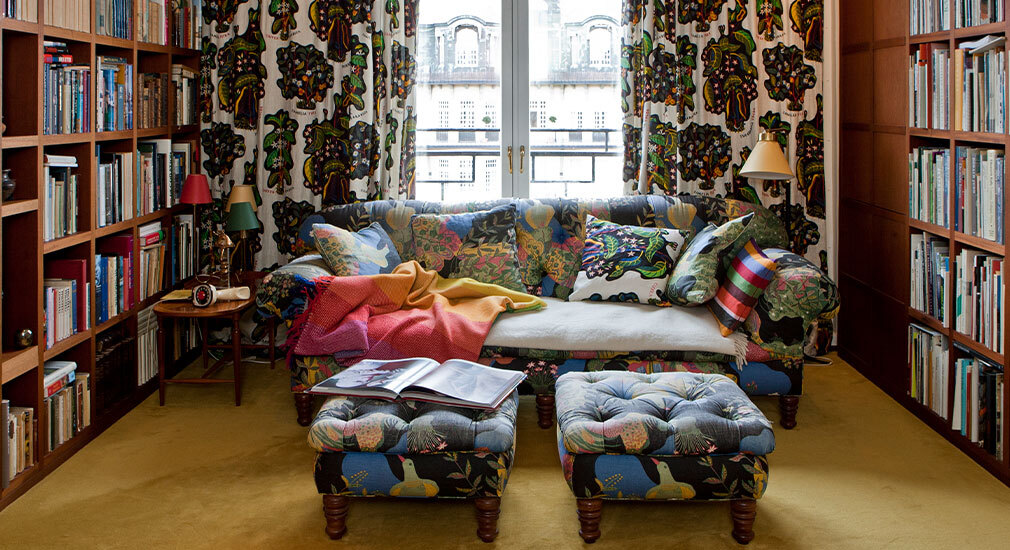
The sofa group by Josef Frank for the Swedish Tenn Company in his significant and extensive reference library of art literature. View the lot with the literature in the catalogue here >
In his private collection there were many works of the Italian Transavant Guard. By Francesco Clemente, Jan Eric had, among other things, the work ”Two Girls”, which won the Venice Biennale in 1988. During his lifetime he came to acquire twenty-two different homes where several were included in prestigious interior design magazines such as Architectural Digest; Connaissance des Arts, House & Garden, Casa Vogue and more. The homes were filled with amazing antiques, art and design that came to be works of art in themselves.
To showcase his home was as obvious to Jan Eric as an artist wanted to show his work – “A home is a form of aesthetics, the person who lives there shows a picture of himself. A home is always a portrait of the person living there.”
Photos: Anne Nyblaues and Kent Billeqvist
To the Löwenadler Collection catalogue >
Check out the digital catalogue here >

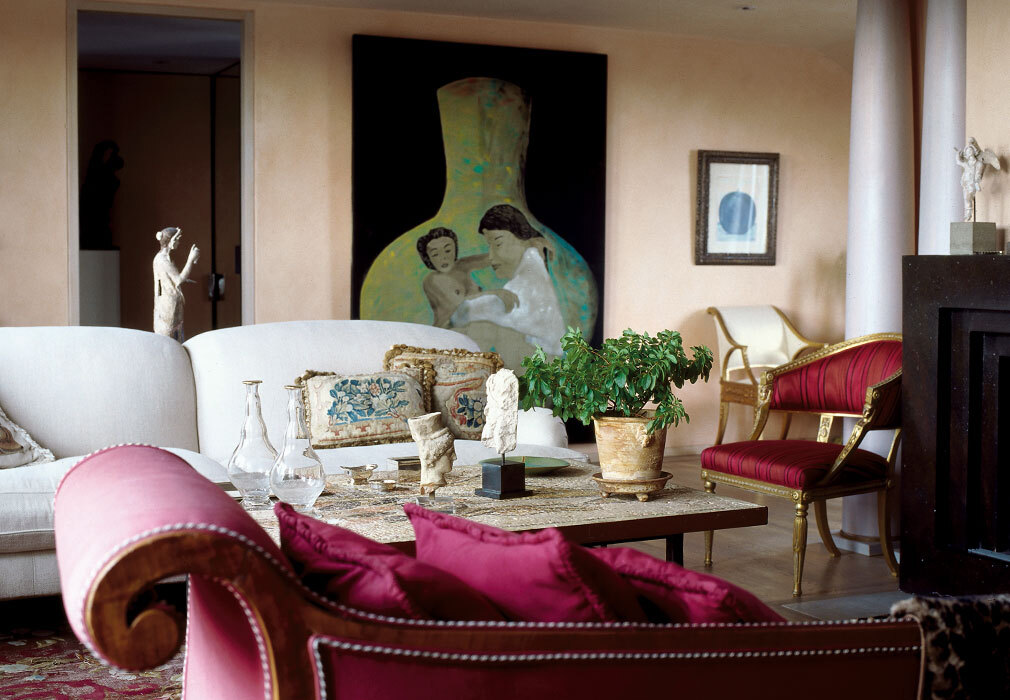
Above: Karl Johan canapé veneered in mahogny, 1820-30s, in the canapé lies four cushions, by the fire place one of a pair of late Gustavian armchairs by Johan Erik Höglander (master in Stockholm 1777), the coffee table comes from The Near East, 6th century AD, on the table two glass bottles from Böhmen, in the background Francesco Clementes "Two girls". In the white sofa in "Howardmodell" lies cushions in tapestry weave.
Photo: Anne Nyblaeus























